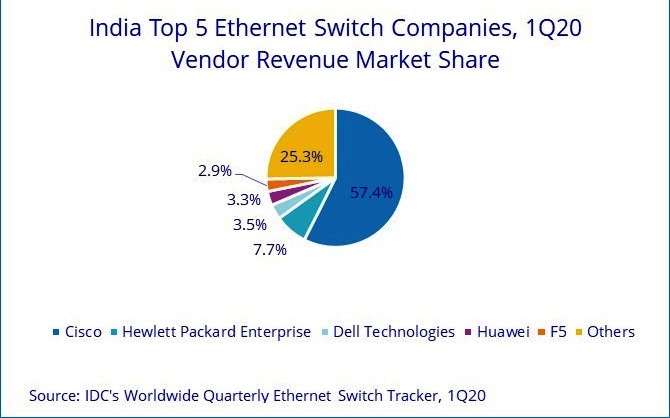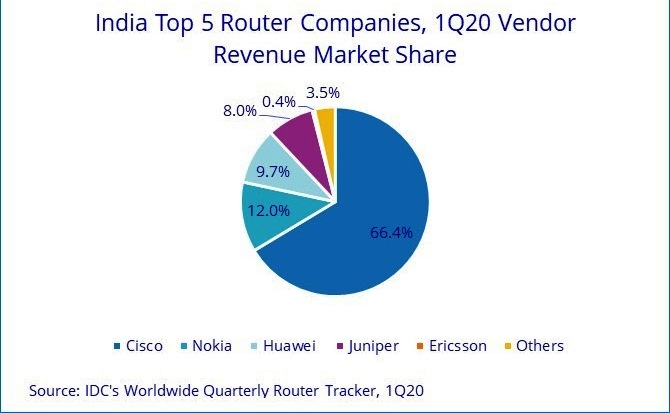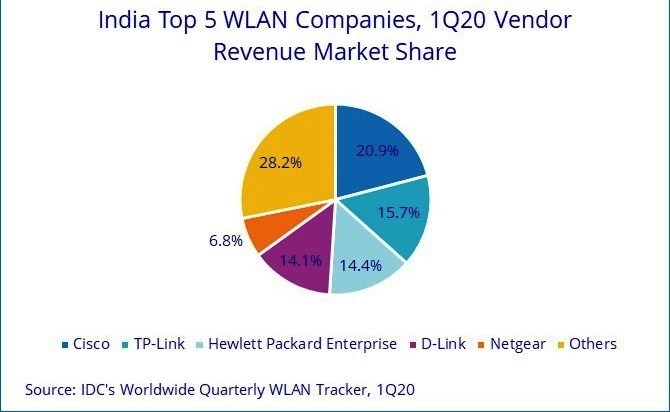New Delhi: Networking market in India which includes ethernet switch, routers, and WLAN segments witnessed a 26.7% year-over-year (YoY) decline in 1Q20, accroding to IDC India.
India started to witness the initial effects of COVID-19 during 1Q20 that resulted into a major slowdown in business activity post mid of March.
Reduction in investment of on-campus infrastructure was the main driver for the slowdown during 1Q20, which led to a fall in the networking market in India.
Routing saw the maximum YoY decline of 48.4% due to the effects of COVID-19, telecom AGR dues, and huge one-time investments that happened during 1Q19. Other categories like switching and WLAN had 10.8% and 16.8% YoY decline respectively.
Ethernet Switch Market 1Q20
The Ethernet Switch market in India stood at $30.3 million (by vendor revenue) in 1Q20 registering a 10.8% YoY decline, according to IDC’s Worldwide Quarterly Ethernet Switch Tracker.
The sluggish demand conditions caused by COVID-19 in India attributed to the market decline. Investments across multiple industries softened due to the lockdown, which led to remote working conditions thereby impacting the investments on-campus infrastructure.
Lockdown impacted vendors depending on China for raw materials and finished goods. Top investments for switches came from services, telecommunications, finance, and government.

Cisco continued to dominate the Ethernet Switch market with a 57.4% share during 1Q20, followed by Hewlett Packard Enterprise (HPE) and Dell Technologies.
Router Market 1Q20
The Router market in India in 1Q20 stood at $ 69.2 million (by vendor revenue) with a steep 48.4% YoY decline, according to IDC’s Worldwide Quarterly Router Tracker.
The slowdown in the router segment during 1Q20 was due to strong investments that happened in 1Q19 coupled with the effects of the pandemic and the AGR penalties.
From a quarter-over-quarter (QoQ) perspective, telecommunications buying remained stagnant. However, the enterprise routing segment had a significant 26.7% QoQ decline.

Cisco leads the router market with a 66.4% market share in 1Q20 followed by Nokia and Huawei.
WLAN Market 1Q20
The WLAN market in India had a 16.8% YoY decline in 1Q20. The market stood at $49.7 million (by Vendor Revenue), according to IDC’s Worldwide Quarterly Wireless LAN Tracker.
Consumer class routers were the most impacted segment. Most of the China based manufacturing got stalled during 1Q20 disrupted the supply.
However, consumer class routers demand is expected to stabilize with increasing remote working needs. Enterprise-class AP’s also declined due to lower demand for campus infrastructure needs. Overall consumer and enterprise-class WLAN declined by 20.5% and 13.6% respectively.

With a 20.9% market share, Cisco topped the market leader position in the WLAN segment during 1Q20, followed by TP-Link and Hewlett Packard Enterprise (HPE).
“While the pandemic will have an immediate negative impact in terms of infrastructure buying, COVID-19 will act as a catalyst in enabling the next wave of digital transformation among enterprises,” said Sudharsan Raghunathan, Senior Market Analyst – Enterprise Networking, IDC India.
“Enterprise networking will slowly move away from point solutions to combining multiple aspects of networking and security under fabric to support the shifting work patterns,” noted Raghunathan.
“Location-based analytics will also play a key role post lockdown, enabling enterprises to trace contacts and social distancing. The COVID-19 situation will enable enterprises to revisit their strategies around cloud, collaboration, and security,” added Raghunathan.
IDC India Forecast
Networking market (Ethernet Switch, Router, and WLAN market) in India will to grow in single digit in terms of compound annual growth rate (CAGR) for 2018–2023, expected IDC analysts.
Increased adoption of emerging technologies such as cloud, IoT, mobility, etc. would drive incremental revenues. IDC also expects large investments for 5G rollouts in the next couple of years.

